Cuenca is a beautiful city, but sometimes a congested one. And, like cities all over the world, it is fighting air pollution from vehicles. To address the issues of congestion and air pollution, and to make it easier for residents and visitors to get around town and to enjoy the city’s natural and historic beauty, Cuenca began a two-pronged thrust through its transportation agency, EMOV, to promote the use of bicycles as a clean and quiet way to travel.
First, the city began construction of the “Ciclovía,” or “bicycle road” – a network of various types of lanes designed to accommodate bikes that runs through most of the city from east to west. And for those without bicycles – or for those who have bikes but either don’t want to worry about securing their bikes when not riding, or who simply don’t have the bikes with them – the city has a bike sharing program that offers use of bicycles at rates starting at 25 cents per half-hour.
As a bicycling enthusiast and recent arrival to Cuenca, I was excited to see the dedicated bike lanes of the Ciclovía and to learn that the city has a bike sharing program similar to the one in my previous home of Chicago.
Here’s what I learned and experienced while trying out these two programs that promote safe bicycling in Cuenca.
Cuenca’s Ciclovía Network
Bike Friendly Recognition
In August, the Cuenca mayor’s website announced that Cuenca received certification from a Spanish biking advocacy group as an International Bike Friendly City, making it the first city in Latin America to receive this honor.
A Big and Growing Network
Cuenca offers 70 km of cycling paths mostly developed over the last 3 years and will expand that to 125km. The website also posits that next to the linear park situated between the Yanuncay river and Av Primero de Mayo there are 3800 bike users per week and similarly impressive numbers are posted for other routes.
The city’s infrastructure for bikes has been designed in a very practical manner. In residential and business areas it offers dedicated bike lanes on city streets and paths meant to be shared with pedestrians. In parks, where there is more space available, many of the dedicated lanes are protected from motor vehicles by low-rise concrete barriers. In some sections, the routes are simply cinder paths that are shared with pedestrians but are quite rideable and are still separated from vehicular traffic.
The bike network extends from Avenida Ordoñez Lasso and Calle de la Dulcamara on the far west side of Cuenca, to approximately one mile past the Parque Los Eucaliptos on the east. It is generally bounded on the south by the Rio Yanuncay and Rio Tomebamba, except for a section farther south, from Parque Inclusivo Circo Social up into the hills of Turi.
Bike Lanes in Densely Populated Areas
Though the bike lanes in the more densely populated parts of Cuenca – along Avenidas Remigio Crespo de Toral, Loja, Solano, Alfonso Moreno Mora, and Remigio Tamariz Crespo, 12 de Abril, and 2 de Agosto – offer a safe way to simply get around town, it’s the sections in the parklands along the rivers that are really the crown jewels of the system.
One can ride next to or very close to the Rio Tomebamba as it winds through the middle of Cuenca. Even with bike lanes, you may not want to start at the westernmost edge and ride down the busy Av. Ordoñez Lasso. Unless you’re a completist, you might – in the interests of safety and comfort, start on the cinder path next to the river at Av. De los Cerezos. From there, you can cycle along the riverside, underneath the busy Av. de la Americas, past the Coliseo and along Av. 12 de Abril as you pass the Universidad de Cuenca, just below the Centro Historico.
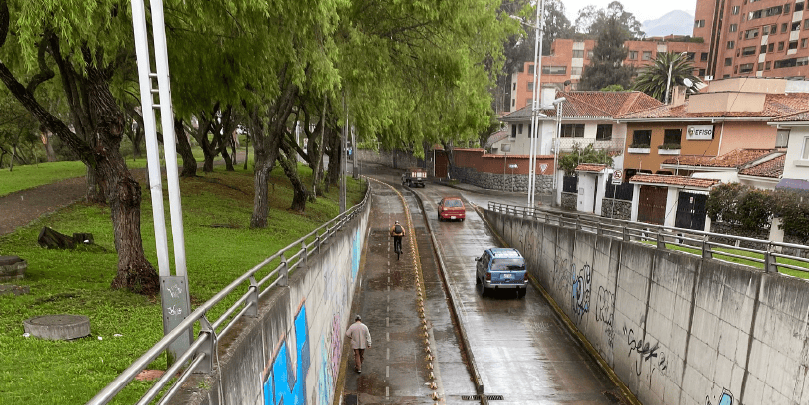
At Av. Solano, you can choose to head south to the Rio Yanuncay and its wooded Parque Lineal or continue along 12 de Abril as you follow the Tomebamba to Parque El Paraiso and see the point where the Tomebamba and the Yanuncay merge. Heading back west along the Yanuncay, you’ll follow the Parque Lineal de Yanuncay, a parkland that with its tree lined riversides and rocky banks in many places looks as if it were far removed from any city. Here, the route is a dedicated and paved two-lane bike path, and when it is adjacent to city streets, is separated by concrete barriers.
Complete Information Available Online
The complete Ciclovía network of bicycle friendly transitways is detailed in the map below, which can be found online.
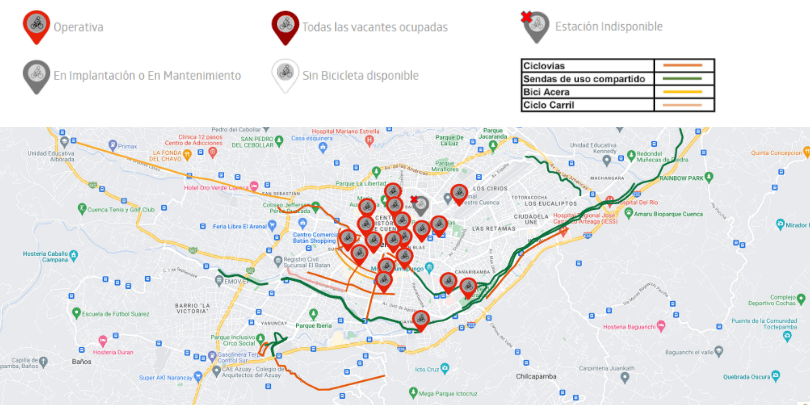
There is also a map in the Manual del Ciclista (Cyclists Manual) distributed by EMOV and available at the Bici Cuenca office on Paseo Tres de Noviembre at the Puente de Juana Oro on the north bank of the Rio Tomebamba just below the Calle Larga.
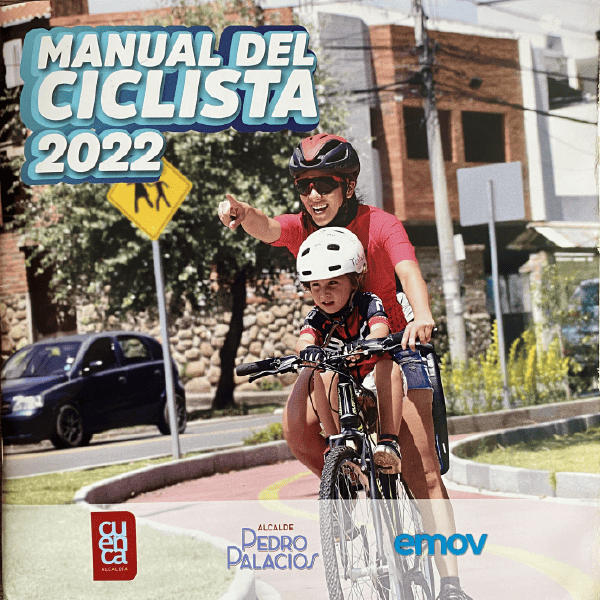
Note: There are discrepancies between these two maps and some errors I noticed when riding parts of the network. Readers are encouraged to also carry detailed city maps when riding the Ciclovía, and not to rely solely on the maps provided by EMOV.
Five Types of Bike Paths
The five types of bicycle paths or trails listed on the online map are as follows:
1. Ciclovías “bicycle road”
These are shown in dark orange lines on the map and represent a dedicated bike lane on a city street, separated from the motor vehicle lanes by a series of metal bumps.
2. Sendas de Uso Compartido “shared paths”
These are shown by green lines on the online map. Despite this translation, on riding some of these routes, I found them to be not shared, but very dedicated to bicycles, with concrete barriers separating the bike lanes from other adjacent traffic lanes.
3. Bici Acera “bike sidewalk”
These are light orange lines on the online map. These denote a bike lane on the sidewalk, adjacent to pedestrian sidewalks.
4. Ciclo Carril “bike lane”
Pink line on the online map. This is a separate bike in each direction on Av. Diez de Agosto only. It’s not separated or protected from vehicular traffic.
5. Senda “path”
Not shown on online map, only in booklet. These are cinder paths that go through sections of some of the parks.
BiciCuenca – Cuenca’s Bike Sharing Program
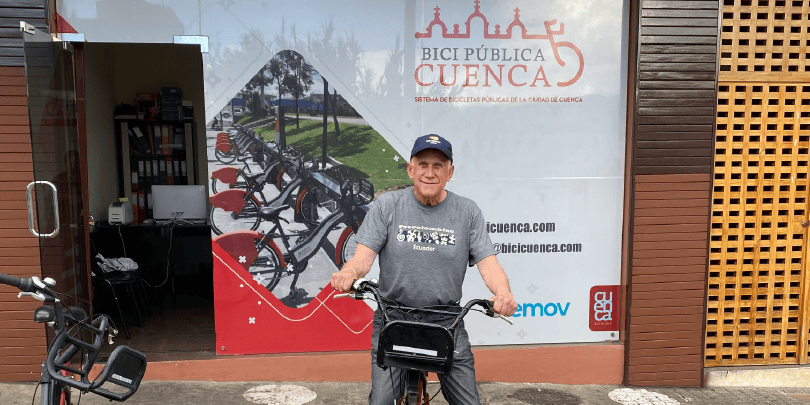
In April 2019, Cuenca began the second prong of its program to promote bicycle ridership – the bike sharing program called Bici Pública Cuenca, or BiciCuenca for short. There are now an estimated 1000 such programs around the world. The first one was launched in Amsterdam, Netherlands, a bicycle-loving city.
Benefits
There are multiple benefits to bike sharing. Most obviously, they give non-bike owners access to bicycles without the cost of buying one or dealing with regular bicycle maintenance. But even more dramatically, it gives bikers the ability to hop on a bicycle on demand, much as they might hail a cab or board a city bus.
BiciCuena Stations
BiciCuenca bikes are kept and locked at 20 stations around the city. Locations are indicated on the Ciclovía map shown above and the number of bikes per station as of this writing ranges from 6 to 21.
BiciCuenca participants can unlock and check out any available bike from any station. There is no way to reserve in advance, so the decision to travel by bike can be spur-of-the-moment and made based on bikes available to rent at any given time at different stations. You can return your rental to any other station, making one-way trips practical. You don’t have to carry a lock or find another suitable place to lock it. So, you are relieved of responsibility for your bike once parked since the docking stations secure it.
The Bikes
BiciCuenca bikes, like those in other bike sharing programs, are solid, durable, unisex 3-speed bikes of a mountain bike type, and accordingly are great for riding on the cinder path trails in the parks. Riders accustomed to a lighter bike will find the BiciCuenca bikes heavy, and when riding uphill may find the 3-speeds inadequate. But they are built to last while serving a variety of riders and are easy to operate.
The gear shift is located on the handlebars, on the right side (sorry, lefties) and gears shift easily. The brakes on the handle are similarly easy to use and are dependable. Ambitious riders planning longer or uphill rides may prefer bikes more specifically designed for their needs, but for purposes of getting around town or enjoying a ride through the parks, the BiciCuenca bikes are quite practical and adequate.
How I Enrolled in BiciCuenca
One can start the registration process online, at www.bicicuenca.com. The site is in Spanish but can be easily translated using the Google Chrome browser. Some of the communications on the website indicate that registration can be completed entirely online, but I got stuck after receiving an email asking me to scan my cedula (a passport is also acceptable for those without cedulas) and my “documents.” I discovered that the documents are downloadable from the website by going to “Terminos del contrato” and “Aviso de Privacidad” under the “Información” menu.
But not being sure about exactly what documents they wanted me to complete, or how to get them, I chose to visit their office to complete the registration. The office is located in the Centro, on Paseo de 3 de Noviembre, a few yards west of the Juana de Oro footbridge (on the Tomebamba River, below Calle Larga). The office is open from 6 am to 8 pm every day of the week.
I visited the office on a Friday afternoon and was helped immediately by the very cordial agent, Fabian Ortiz. Sr. Ortiz was not an English speaker, and my Spanish is limited, but I managed with the help of my bi-lingual husband. With my cedula number, Fabian was able to quickly find the application I had started online and printed out the documents I needed to sign. Frankly, I didn’t read all the documents before signing them, but from scanning them I gathered they were simply all about promising to follow the rules of the road, the rules of BiciCuenca, and to assume liability for any damage. With all the documents signed, I needed only to make payment for my registration and initial balance to pay for trips. I was given a membership card, which is used to retrieve bikes from the stations.
Membership Options and Costs
The fee to initiate a membership is $8.96, which includes taxes and an initial $5.00 balance to pay for rides. One may pay by cash or debit card and there may be a deposit requested. The Daily membership for $10 is for those that want the freedom to ride a bike all day without docking the bike at maximum 30 minute intervals. The quarterly and annual membership that may make sense for those who expect to take numerous trips of less than half an hour. The Daily membership might be a good choice for those seeking Recreation with the other two for those who need limited Transportation.
- Daily membership: $10.00 (Unlimited travel time within service hours, 6am- 8pm)
- Quarterly membership: $15.00 (unlimited half-hour trips for three months)
- Annual membership: $30.00 (unlimited half-hour trips for the year)
None of those memberships are required. One can simply pay as they go. A daily $10 membership frees you from the 30 minute time limit. But with or without a quarterly or annual membership, usage rules are designed to encourage short rides of 30 minutes or less.
And fine amounts are posted on the website too:
- 0 – 30 minutes over: Free with membership, $.25 without membership
- 31 – 60 minutes over: $0.50
- Each additional hour or fraction of an hour: $2.00
- More than 24 hours: $250 (yes, don’t forget about it overnight!)
- New card: $6
Given that my plans were to take primarily recreational rides of more than a half-hour, I chose not to buy any of the membership options, but to pay as YOU go.
Getting Ready
Now armed with my membership card, Fabian took me outside to show me how the bikes work – (Image) explaining how the gear shift and the breaks operate. I asked about a map of the Ciclovía and was given a copy of the “Manual del Ciclista 2002” published by EMOV, which includes a map (though as noted above, it has some differences with the map published online).
The “Manual del Ciclista,” in Spanish, is primarily a guide for bicycling – suitable for the beginning bicyclist. After making a case for the benefits of urban bicycling, it provides a comparison of the various types of bicycles, the standard structure and features of bikes, how to adjust them to the specific user, maintain proper tire pressure, rules of the road, safety practices (including wearing of helmets) and first aid practices. The information will be familiar to experienced and responsible riders but is a complete introduction to the newbie and a good review for all.
The BiciCuenca App
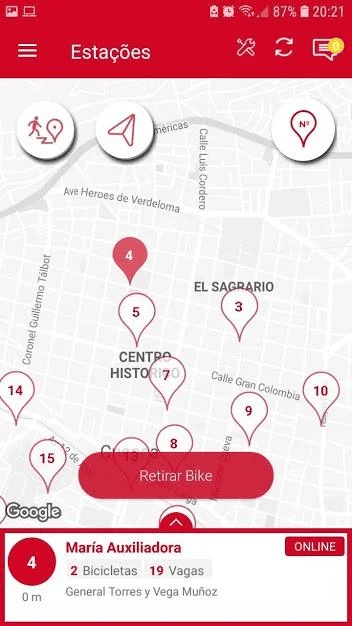
This well-designed app for iPhones or Androids is a must and is available through the Apple App Store and Google Play Store. It can display info in English and not only offers real-time information about the availability of bikes but is also used to take out bikes for use.
Its “Stations” tab provides a list of the 20 stations, shows the number of bikes currently available at each, and shows the station location on a map.
The “My Passes” tab shows the user’s current balance or membership and the “Payments” tab shows payments that have been made on account.
The “My Journeys” tab gives a summary of trips/rentals the rider has taken and the “Report Issue” tab gives the user the opportunity to report a problem with a bike or a particular station.
Finally, the “About the Project” tab has a link to call customer service – which is attended from 6 am to 8 pm.
Taking a Trip
How to retrieve and return a bike
First, you’ll choose the station from which you’ll begin your trip. In either the app or on the website, you can find the most convenient station and see if they currently have a bike available. At the station, you’ll see the bicycles securely locked in a rack and a terminal. There are three ways to provide your membership information to log in and begin a bike rental. I had some trouble figuring out how to do this on my first ride, so my husband and I paid a return visit to the Bici Cuenca office and another agent, Luis Cabrera, walked us over to the Centennial station across the footbridge from the office and patiently demonstrated the three methods.
1. The Smartphone app
Log in with your username and password. After logging in successfully, you will select the station you’re at, choose a slot on the rack that has an available bike, and confirm that you want to take the bike. After you see a green light go on and hear a rather loud mechanical noise, the bike will be unlocked and you will lift it out of its slot. You’ll be ready to take the bike for a ride.
2. The Cuenca public bike card
Show this to the reader on the terminal. This will log you in to your account and you will proceed with your selections and bike retrieval just as described for the smartphone method above.
3. Enter your username and password on the terminal screen
Choose “Sin Tarjeta” (without card) first and fields to enter your phone number and password will appear. Once you’ve entered your data correctly, you will be able to proceed with your selections and bike retrieval just as described for the smartphone method above.
When your trip is complete, you can return the bike to any of the 21 stations. To return the bike, you will choose an empty slot and lift the front of the bike so that the small box on the front of the frame fits into that slot’s square hole on the bike rack. Once the box is in the hole, you’ll hear a clicking sound and the bike will be securely locked, completing your trip.
Bikes may only be taken out or returned during the service hours of 6 am to 8 pm daily.
My Test Trip
After completing my registration and paying cash for the membership fee and adding an additional balance for my account, I was given my Cuenca public bike card and was ready to ride. Well, nearly ready. I asked Fabian if helmets were required and he said they are not mandatory but are highly recommended. If you’ve ever heard (as I have) the sound of a skull hitting the pavement when a bicyclist wipes out, you’ll know why. The next day I visited the aptly named store called “Bike Shop” in the Batan Mall and found a great selection of bike helmets and other accessories from which to choose. Bonus tip: if you have a YapaTree Card, you can get a discount on a helmet at Coral.
Launched near Parque Calderon in El Centro
I began my first Bici Cuenca trip at the station just off Parque Calderón, at the corner of Luis Cordero and Mariscal Sucre. I headed east and south through the Centro, down the bumpy brick and stone streets, until I arrived at Calle Larga, turning east and downhill before crossing the Rio Tomebamba and merging onto Av. 12 de Abril, along the river. The route took me to the Parque Paraiso, where a dirt path led me to the point at which the Tomebamba and Yanuncay rivers meet.
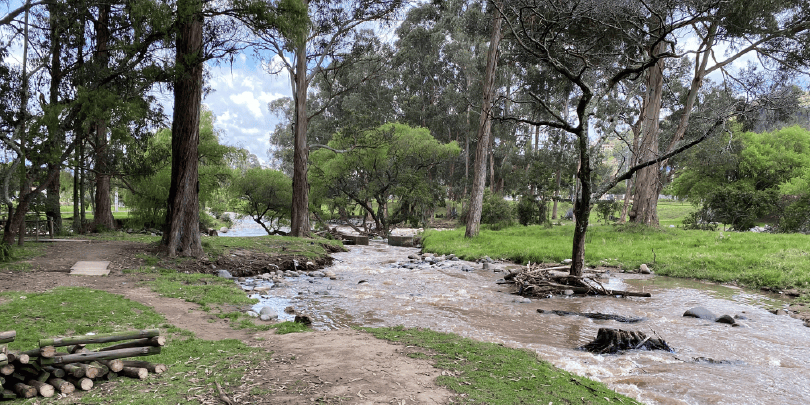
I decided to head back west, following a path into a popular section of the park where Cuencanos were enjoying a sunny Sunday afternoon.
At the edge of the park, I found one of the paved and protected (by low concrete walls) bikeways that I would follow across the south-central section of the city. The Ciclovía took me first through parkland:
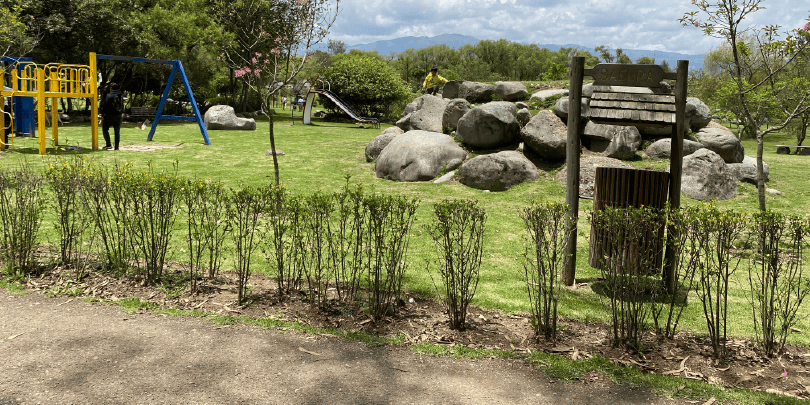
Then, through a residential section of the Huayna-Capac barrio before going back into parkland near the Tres Puentes (“three bridges”) – a scenic point of two modern bridges crossing the Yanuncay with an old bridge (now a footbridge) in between. From there I followed the same sort of protected bikeway along the Yanuncay Parque Lineal. This section of the Ciclovía continues as a paved, protected bikeway through the wooded park along the river all the way to Av. de las Américas, and continues beyond via a cinder path that goes under the street and extends through the park another quarter mile or so.
Steered homeward
I left the Ciclovía at Av. Loja to head to the station nearest my home so I could complete the trip. This being my first bike ride in several years, I decided to play it safe after I started to feel tired and winded. My trip along the Rios Tomebamba and Yanuncay was mostly on level ground, but a little tiring for me, nonetheless. Looking at the uphill climb up Av. Loja from Av. 1 de Mayo to the intersection of Av. México and Av. 10 de Agosto, I felt no shame in walking the bike until I reached level ground. From there it was an easy ride down a historic section of Av. Loja – a stretch that is often considered part of the Centro Historico, but because it is less developed than the Centro, strikes me as more authentic and of another time than the Centro.
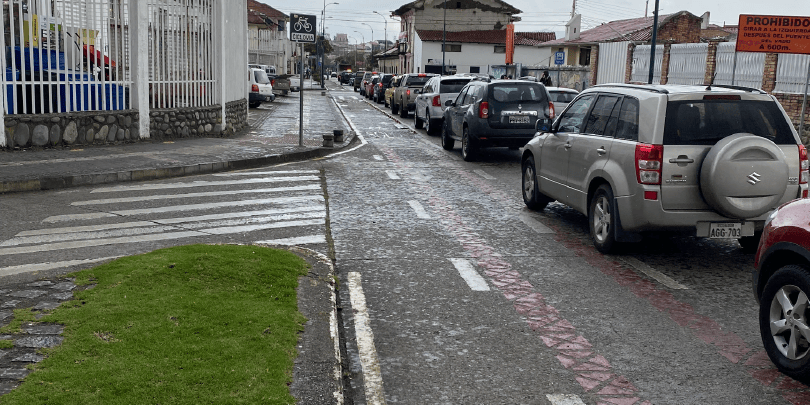
Finishing the trip
I ended my trip at the Bici Cuenca station on the broad Av. Remigio Crespo Toral just east of its intersection with Loja. After locking my bike, the “My Journeys” section on my app told me my trip had lasted an hour and 39 minutes, and I saw on the “My Passes” tab that my available balance had been reduced by $2.75 ($.25 for the first half hour, $.50 for the second half hour, and $2.00 for the partial second hour). Not a bad price for a trip that took me through historic sections, along the banks of two of Cuenca’s rivers, and through some of its beautiful parks. I’m looking forward to exploring more of the Ciclovía’s bikeways – maybe riding along the western portion of the Tomebamba or riding out to the eastern edge of that river and seeing where it meets the Rio Machángara.
Summary
With a small investment of time and an even smaller investment of money, the Bici Cuenca is a great way to enjoy the natural beauty and history of Cuenca by making use of the extensive and growing Ciclovía network.
Please share your cycling comments or questions in the Comments section or in our Cuenca Facebook Group. See on the bike trails!

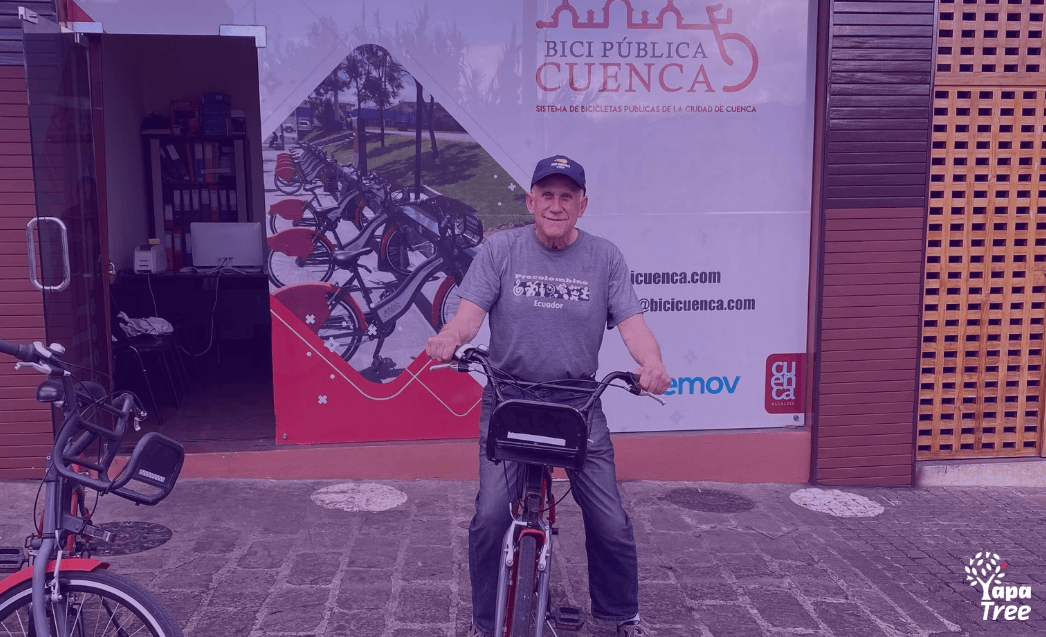



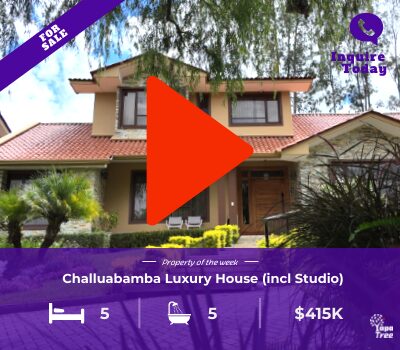
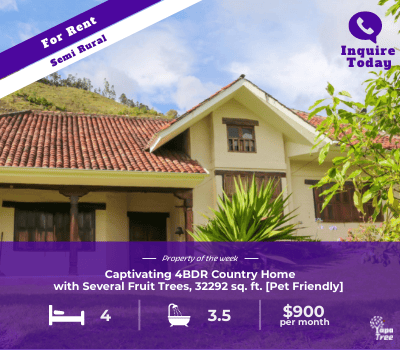




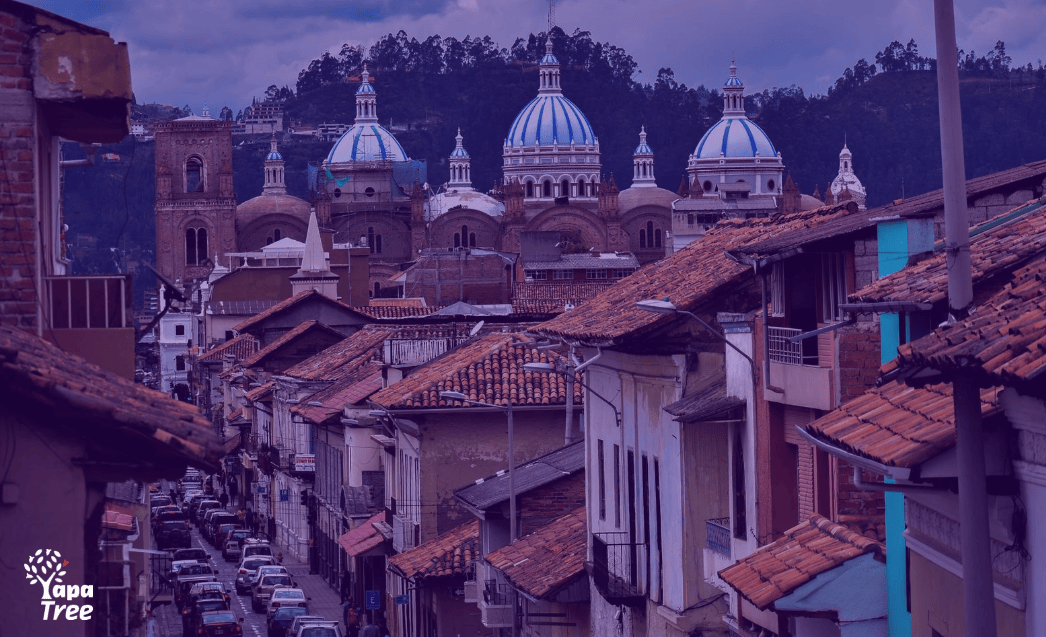
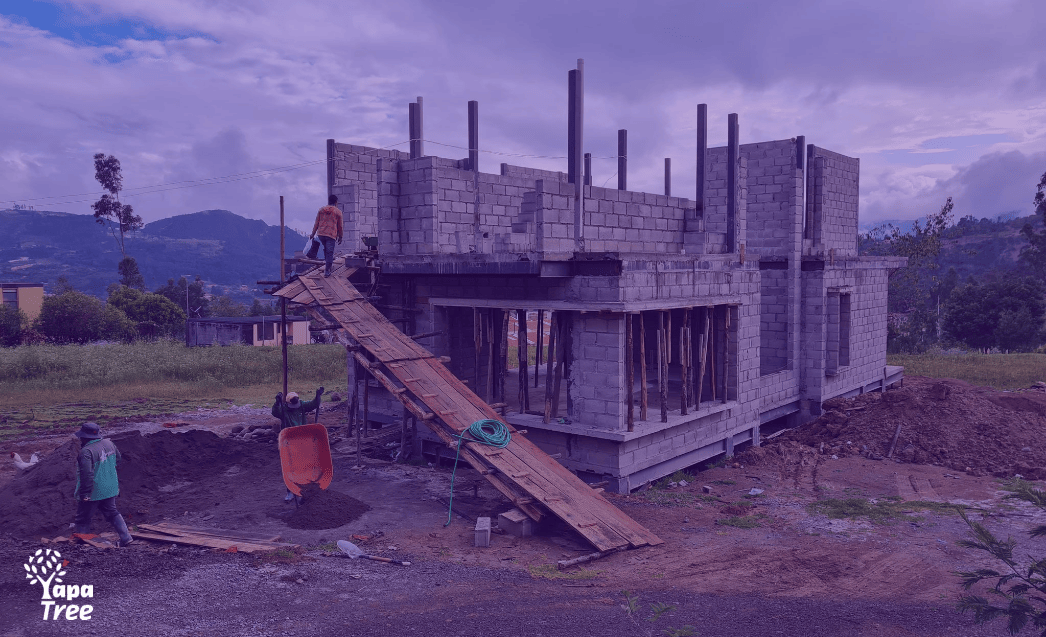

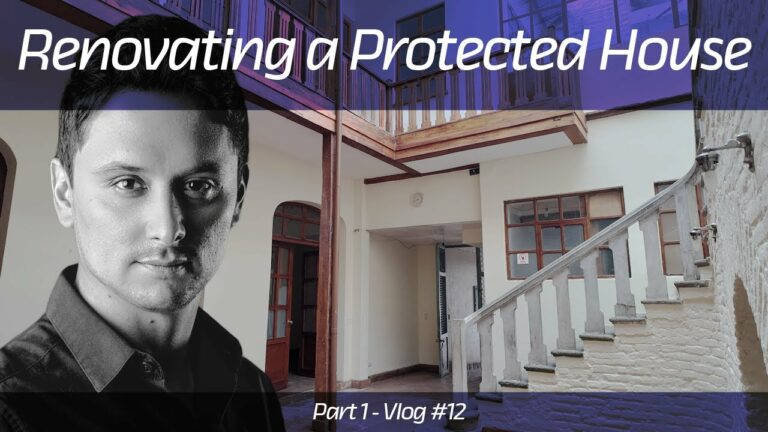

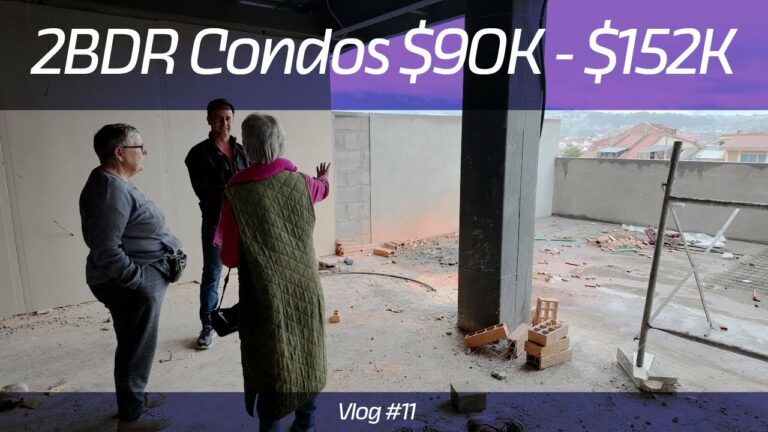

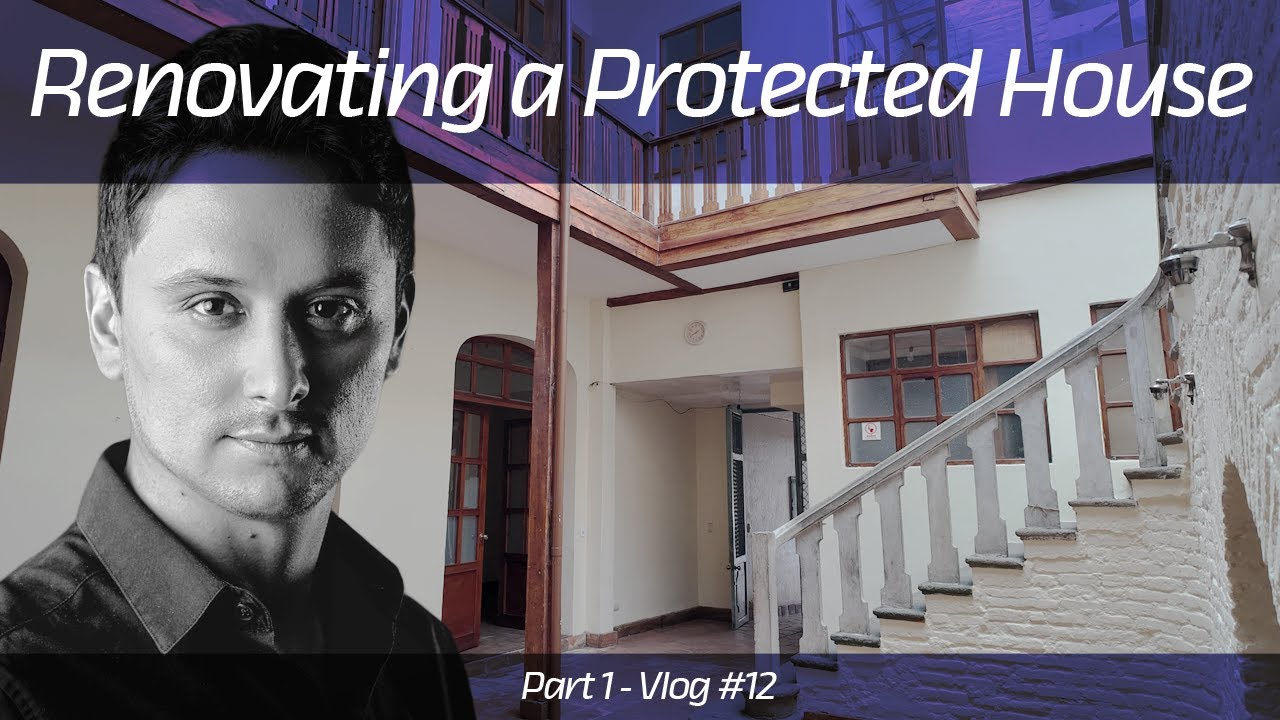

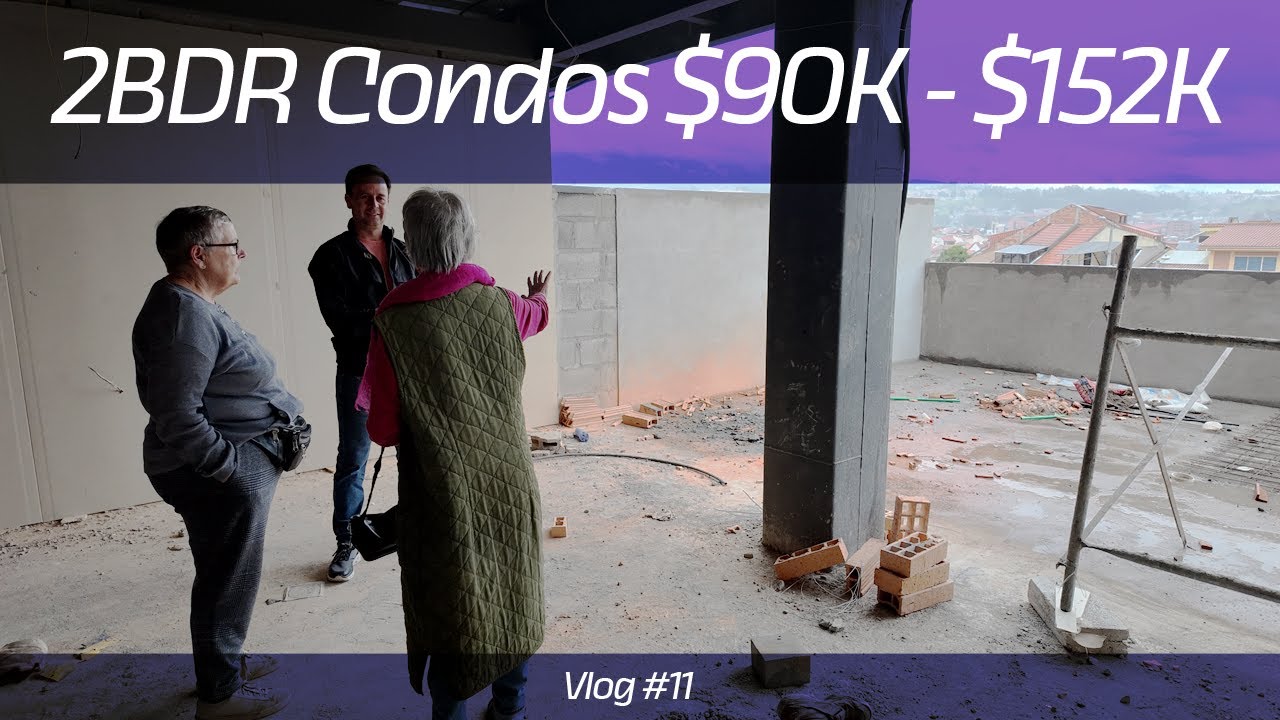
One Response
I am trying to get the city to add a ciclovia to 3 de Noviembre from Ave Las Americas out to Ave. Los Cerezos where the new U Cuenca campus it. They acknowedged my request, and I am hopeful they do this. I walk the path along the Tomebamba most days, and it is not friendly for both bikes and pedestrians, which there are many (however no gringos). The cars speed way to much on 3 de Noviembre and a ciclovia would slow them down, get the bikes off the walking path, and create a non stop bikeway from El Centro to the newish campus. It would be a win for everybody including students except the drivers who race up that street like there is no tomorrow. Any support welcome